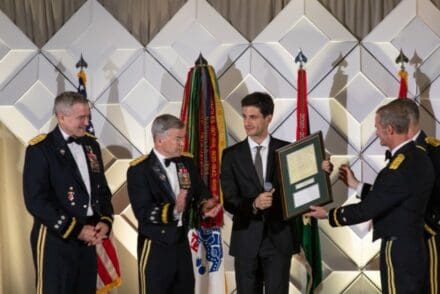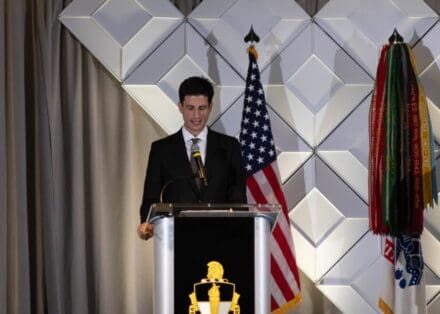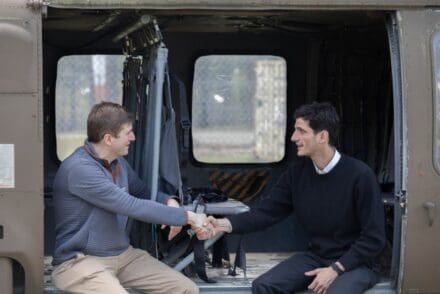In an honorable and dignified ceremony marked by historical significance, former President John F. Kennedy was officially inducted as a Distinguished Member of the Special Forces Regiment in Pinehurst, North Carolina, April 11.

The U.S. Army Regimental Honors program recognizes individuals who have significantly contributed to the welfare, strength, and legacy of a regiment. The ceremony honored Kennedy posthumously, recognizing his visionary support for Special Forces and his enduring influence on modern warfare.
Jack B. Kennedy Schlossberg, Kennedy’s grandson, accepted the official acknowledgement of Kennedy’s induction into the regiment from Maj. Gen. Jason C. Slider, commanding general of the U.S. Army John F. Kennedy Special Warfare Center and School, the Special Operations Center of Excellence (SOCoE).

“Today, I’ll never forget it,” Schlossberg said, who accepted the distinction on his family’s behalf. “I can’t think of a better way to honor President Kennedy by teaching new generation to live by the values that he did and to hold them to the same high standard that history holds them to. The Special Warfare School is a living tribute to all that my grandfather stood for.”
In addition to Kennedy’s contribution to Special Forces history stood the former schoolhouse commander at the time, Lt. Gen. William P. Yarborough, whose determination parallelled the vision in establishing what would become the next generation of lethal warfighters, the Special Forces Soldier.

“Yarborough was a warfighter,” Slider said. “He fought and commanded in World War II with the 82nd Airborne Division. He was a leader of men, and he cared for them. He created the silver wings many of us are wearing tonight. He also designed the paratrooper jump boots. He was an infantryman, but his legacy is “the father of the modern Green Berets.”
Michael Yarborough, Lt. Gen. Yarborough’s grandson, attended the ceremony on his family’s behalf.
“This letter marked the milestone in the transformation to the Army as it responded to a wide variety of new and emerging threats that included unconventional warfare in faraway places like Vietnam,” said Yarborough, during his remarks at the induction ceremony. “Six months before he penned that letter, Kennedy visited Fort Bragg and my grandfather at the Special Warfare School […] I’m confident that President Kennedy, if he visited Bragg today, would look to Special Forces to bring any capabilities and moral character the Army needs as it continues to defend our country.”
The significance of the ceremony reflected a milestone in Special Forces history, the 63rd anniversary of Kennedy signing the memo that authorized the wearing of the Green Beret on April 11, 1962.
Because of Kennedy and Yarborough’s deep-rooted legacy in paving the path for Army special operations forces, the U.S. Army John F. Kennedy Special Warfare Center and School stands as a living legacy of their contributions and a pillar of excellence in the world of special operations military training and force generation.
Kennedy’s military history traces back during his time as a lieutenant in the U.S. Navy during World War II. Kennedy’s actions spoke to his character when he commanded a PT boat in the Pacific. In 1943, his boat, PT-109, was rammed and sunk by a Japanese destroyer. Despite his own injuries, Kennedy led his crew to safety. After World War II, Kennedy would go on to be elected as a democratic congressman for Massachusetts, serving three terms, and eventually becoming the 35th President of the United States of America in 1960.
During his presidency, in October 1961, after watching a demonstration of Special Forces capabilities at McKellar’s Lodge, Kennedy approved the Green Beret as the official headgear of Army Special Forces during his visit to Fort Bragg.
Following his visit on April 11, 1962, Kennedy penned an official White House Memorandum stating, “The Green Beret is again becoming a symbol of excellence, a badge of courage, a mark of distinction in the fight for freedom.”
Shortly after Kennedy’s assassination, as a tribute to his support, Yarborough added Kennedy’s name to the U.S. Army Center for Special Warfare, the previous name of the SOCoE. Named in his honor, the institution reflects Kennedy’s unwavering belief and executive sponsorship of unconventional warfare. His contribution to the fabric of Special Forces history was filled with many accomplishments and honorable service in the military, leading to his induction into the regiment.
While the induction falls on the anniversary of the signing of the memo, the induction references an action taken when Kennedy was first interred into Arlington.
At that time, moments after the assassinated president’s casket descended into the ground, boughs of pines were laid on the mound, and his 47-man Special Forces contingent that supported his internment was leaving, former Command Sgt. Maj. Francis Ruddy, the U.S. Army Center for Special Warfare command sergeant major, overcome by emotion, laid his beret down on the grave site.
“It was pretty much a reflex,” Ruddy said 14 months later with a New York Times reporter. “I stood there with a feeling of complete helplessness. I felt we lost a truly great person.”
When Robert F. Kennedy and Jackie returned to Arlington at midnight, they found Ruddy’s beret among the pine boughs that laid on top of the piled dirt. Ruddy explained to the Associated Press days after the funeral that “we considered it appropriate that it be given back to him.”
“President Kennedy’s confidence in our formation, his investment in our force, and his understanding of unconventional warfare leads us to stand as ready to respond to our nation today as we did 60 years ag,” said Lt. Gen. Jonathan P. Braga, commanding general of the U.S. Army Special Operations Command, during the induction ceremony. “As past Green Berets were able to stand guard over President Kennedy and honor his leadership in his family’s time of need; today, we Green Berets codify his legacy as one strongly intertwined with our own.”
During the ceremony, Schlossberg presented Gen. Bryan P. Fenton, commanding general of the U.S. Special Operations Command, with a page of Kennedy’s famous West Point speech in 1962 that included President Kennedy’s notes and edits from over six decades ago.
“On behalf of all of us, we formally welcome you to the Special Forces family,” Fenton said, during closing remarks.
Kennedy remains the only American president officially inducted into the Special Forces Regimental Hall of Fame as a Distinguished Member of the Regiment. His image, depicted in Special Forces halls and classrooms, continues to inspire generations of warriors. The ceremony not only honored his past contributions but also reaffirmed that his ideals remain firmly embedded in the heart of special operations.
To read President John F. Kennedy’s biography from the ceremony, visit www.swcs.mil/Portals/111/DMOR_2025_SF_JFK
By Elvia Kelly, U.S. Army John F. Kennedy Special Warfare Center and School
You can skip to the end and leave a response. Pinging is currently not allowed.
Read the full article here



